Microstructures and Interface Magnetic Moments in Mn2VAl/Fe Layered Films Showing Exchange Bias
Abstract
:1. Introduction
2. Materials and Methods
3. Results and Discussion
4. Conclusions
Author Contributions
Funding
Data Availability Statement
Conflicts of Interest
References
- Graf, T.; Felser, C.; Parkin, S.S.P. Simple rules for the understanding of Heusler compounds. Prog. Solid State Chem. 2011, 39, 1–50. [Google Scholar] [CrossRef]
- Felser, C.; Hirohata, A. (Eds.) Heusler Alloys; Springer International Publishing: Berlin/Heidelberg, Germany, 2016. [Google Scholar] [CrossRef]
- Baltz, V.; Manchon, A.; Tsoi, M.; Moriyama, T.; Ono, T.; Tserkovnyak, Y. Antiferromagnetic spintronics. Rev. Modern Phys. 2018, 90. [Google Scholar] [CrossRef] [Green Version]
- Dieny, B.; Speriosu, V.S.; Parkin, S.S.P.; Gurney, B.A.; Wilhoit, D.R.; Mauri, D. Giant magnetoresistive in soft ferromagnetic multilayers. Phys. Rev. B 1991, 43, 1297–1300. [Google Scholar] [CrossRef]
- O’Grady, K.; Fernandez-Outon, L.E.; Vallejo-Fernandez, G. A new paradigm for exchange bias in polycrystalline thin films. J. Magn. Magn. Mater. 2010, 322, 883–899. [Google Scholar] [CrossRef]
- Nayak, A.K.; Nicklas, M.; Chadov, S.; Khuntia, P.; Shekhar, C.; Kalache, A.; Baenitz, M.; Skourski, Y.; Guduru, V.K.; Puri, A.; et al. Design of compensated ferrimagnetic Heusler alloys for giant tunable exchange bias. Nat. Mater. 2015, 14, 679–684. [Google Scholar] [CrossRef] [PubMed] [Green Version]
- Dong, X.; Dong, J.; Xie, J.; Shih, T.; McKernan, S.; Leighton, C.; Palmstrøm, C. Growth temperature controlled magnetism in molecular beam epitaxially grown Ni2MnAl Heusler alloy. J. Cryst. Growth 2003, 254, 384–389. [Google Scholar] [CrossRef]
- Tsuchiya, T.; Kubota, T.; Sugiyama, T.; Huminiuc, T.; Hirohata, A.; Takanashi, K. Exchange bias effects in Heusler alloy Ni2MnAl/Fe bilayers. J. Phys. D Appl. Phys. 2016, 49, 235001. [Google Scholar] [CrossRef]
- Tsuchiya, T.; Kubota, T.; Sasaki, T.; Takanashi, K. Blocking temperature enhancement in Ni2MnAl/Fe bilayers by thermal treatments. J. Magn. Magn. Mater. 2019, 478, 206–210. [Google Scholar] [CrossRef]
- Balluff, J.; Meinert, M.; Schmalhorst, J.M.; Reiss, G.; Arenholz, E. Exchange bias in epitaxial and polycrystalline thin film Ru2MnGe/Fe bilayers. J. Appl. Phys. 2015, 118, 243907. [Google Scholar] [CrossRef] [Green Version]
- Balluff, J.; Huminiuc, T.; Meinert, M.; Hirohata, A.; Reiss, G. Integration of antiferromagnetic Heusler compound Ru2MnGe into spintronic devices. Appl. Phys. Lett. 2017, 111, 032406. [Google Scholar] [CrossRef] [Green Version]
- Wu, H.; Vallejo-Fernandez, G.; Hirohata, A. Magnetic and structural properties of antiferromagnetic Mn2VSi alloy films grown at elevated temperatures. J. Phys. D Appl. Phys. 2017, 50, 375001. [Google Scholar] [CrossRef] [Green Version]
- Huminiuc, T.; Whear, O.; Takahashi, T.; Young Kim, J.; Vick, A.; Vallejo-Fernandez, G.; O’Grady, K.; Hirohata, A. Growth and characterisation of ferromagnetic and antiferromagnetic Fe2+xVyAl Heusler alloy films. J. Phys. D Appl. Phys. 2018, 51, 325003. [Google Scholar] [CrossRef]
- Wu, H.; Sudoh, I.; Xu, R.; Si, W.; Vaz, C.A.F.; Young Kim, J.; Vallejo-Fernandez, G.; Hirohata, A. Large exchange bias induced by polycrystalline Mn3Ga antiferromagnetic films with controlled layer thickness. J. Phys. D Appl. Phys. 2018, 51, 215003. [Google Scholar] [CrossRef]
- Ogasawara, T.; Young Kim, J.; Ando, Y.; Hirohata, A. Structural and antiferromagnetic characterization of noncollinear D019 Mn3Ge polycrystalline film. J. Magn. Magn. Mater. 2019, 473, 7–11. [Google Scholar] [CrossRef]
- Hirohata, A.; Huminiuc, T.; Sinclair, J.; Wu, H.; Samiepour, M.; Vallejo-Fernandez, G.; O’Grady, K.; Balluf, J.; Meinert, M.; Reiss, G.; et al. Development of antiferromagnetic Heusler alloys for the replacement of iridium as a critically raw material. J. Phys. D Appl. Phys. 2017, 50, 443001. [Google Scholar] [CrossRef]
- Itoh, H.; Nakamichi, T.; Yamaguchi, Y.; Kazama, N. Neutron diffraction study of Heusler type alloy Mn0.47V0.28Al0.25. Trans. Jpn. Inst. Met. 1983, 24, 265–271. [Google Scholar] [CrossRef] [Green Version]
- Nakamichi, T.; Stager, C. Phenomenological formula of NMR satellite of Heusler alloys and magnetic structure of Mn2VAl. J. Magn. Magn. Mater. 1983, 31–34, 85–87. [Google Scholar] [CrossRef]
- Kubota, T.; Kodama, K.; Nakamura, T.; Sakuraba, Y.; Oogane, M.; Takanashi, K.; Ando, Y. Ferrimagnetism in epitaxially grown Mn2VAl Heusler alloy investigated by means of soft X-ray magnetic circular dichroism. Appl. Phys. Lett. 2009, 95, 222503. [Google Scholar] [CrossRef]
- Klaer, P.; Jorge, E.A.; Jourdan, M.; Wang, W.H.; Sukegawa, H.; Inomata, K.; Elmers, H.J. Temperature dependence of X-ray absorption spectra in the ferromagnetic Heusler alloys Mn2VAlandCo2FeAl. Phys. Rev. B 2010, 82. [Google Scholar] [CrossRef]
- Meinert, M.; Schmalhorst, J.M.; Reiss, G.; Arenholz, E. Ferrimagnetism and disorder of epitaxial Mn2-xCoxVAl Heusler compound thin films. J. Phys. D Appl. Phys. 2011, 44, 215003. [Google Scholar] [CrossRef] [Green Version]
- Ishida, S.; Asano, S.; Ishida, J. Bandstructures and Hyperfine Fields of Heusler Alloys. J. Phys. Soc. Jpn. 1984, 53, 2718–2725. [Google Scholar] [CrossRef]
- Galanakis, I.; Dederichs, P.H.; Papanikolaou, N. Slater-Pauling behavior and origin of the half-metallicity of the full-Heusler alloys. Phys. Rev. B 2002, 66, 174429. [Google Scholar] [CrossRef] [Green Version]
- Umetsu, R. Search of Novelty Mn-Based Heusler Alloys with High Half-Metallicity and High Phase Stability. 2013 Fiscal Year Final Research Report of Grants-in-Aid for Scientific Research Program by Japan Society for Promotion of Science, 2014. In Japanese. 2014. Available online: https://kaken.nii.ac.jp/en/grant/KAKENHI-PROJECT-24656366/ (accessed on 30 May 2021).
- Umetsu, R.Y.; Saito, K.; Ono, K.; Sato, K.; Fukushima, T.; Kuroda, F.; Oguchi, T. Magnetic Properties and Electronic State of Mn-based Heusler Alloys. Mater. Jpn. 2021, 60, 205–211. [Google Scholar] [CrossRef]
- Tsuchiya, T.; Kobayashi, R.; Kubota, T.; Saito, K.; Ono, K.; Ohhara, T.; Nakao, A.; Takanashi, K. Mn2VAl Heusler alloy thin films: Appearance of antiferromagnetism and exchange bias in a layered structure with Fe. J. Phys. D Appl. Phys. 2018, 51, 065001. [Google Scholar] [CrossRef] [Green Version]
- Tsuchiya, T. Exchange Bias Properties Using Antiferromagnetic Heusler Alloys: Ni2MnAl and Mn2VAl. Ph.D. Thesis, Tohoku University, Sendai, Japan, 2018; pp. 33, 94–95. [Google Scholar]
- Ohldag, H.; Scholl, A.; Nolting, F.; Arenholz, E.; Maat, S.; Young, A.T.; Carey, M.; Stöhr, J. Correlation between Exchange Bias and Pinned Interfacial Spins. Phys. Rev. Lett. 2003, 91. [Google Scholar] [CrossRef] [Green Version]
- Tsunoda, M.; Nakamura, T.; Naka, M.; Yoshitaki, S.; Mitsumata, C.; Takahashi, M. Soft X-ray magnetic circular dichroism study of Mn-Ir/Co-Fe bilayers with giant exchange anisotropy. Appl. Phys. Lett. 2006, 89, 172501. [Google Scholar] [CrossRef]
- Shiratsuchi, Y.; Noutomi, H.; Oikawa, H.; Nakamura, T.; Suzuki, M.; Fujita, T.; Arakawa, K.; Takechi, Y.; Mori, H.; Kinoshita, T.; et al. Detection and in situ Switching of Unreversed Interfacial Antiferromagnetic Spins in a Perpendicular-Exchange-Biased System. Phys. Rev. Lett. 2012, 109, 077202. [Google Scholar] [CrossRef]
- Saitoh, Y.; Fukuda, Y.; Takeda, Y.; Yamagami, H.; Takahashi, S.; Asano, Y.; Hara, T.; Shirasawa, K.; Takeuchi, M.; Tanaka, T.; et al. Performance upgrade in the JAEA actinide science beamline BL23SU at SPring-8 with a new twin-helical undulator. J. Synchrotron Radiat. 2012, 19, 388–393. [Google Scholar] [CrossRef] [PubMed] [Green Version]
- Nagai, K.; Fujiwara, H.; Aratani, H.; Fujioka, S.; Yomosa, H.; Nakatani, Y.; Kiss, T.; Sekiyama, A.; Kuroda, F.; Fujii, H.; et al. Electronic structure and magnetic properties of the half-metallic ferrimagnet Mn2VAl probed by soft X-ray spectroscopies. Phys. Rev. B 2018, 97, 035143. [Google Scholar] [CrossRef] [Green Version]
- Chen, C.T.; Idzerda, Y.U.; Lin, H.J.; Smith, N.V.; Meigs, G.; Chaban, E.; Ho, G.H.; Pellegrin, E.; Sette, F. Experimental Confirmation of the X-ray Magnetic Circular Dichroism Sum Rules for Iron and Cobalt. Phys. Rev. Lett. 1995, 75, 152–155. [Google Scholar] [CrossRef] [PubMed]
- Alouani, M.; Wills, J.M.; Wilkins, J.W. Scaling of the L2,3 circular magnetic X-ray dichroism of Fe nitrides. Phys. Rev. B 1998, 57, 9502–9506. [Google Scholar] [CrossRef]
- Elmers, H.J.; Fecher, G.H.; Valdaitsev, D.; Nepijko, S.A.; Gloskovskii, A.; Jakob, G.; Schönhense, G.; Wurmehl, S.; Block, T.; Felser, C.; et al. Element-specific magnetic moments from core-absorption magnetic circular dichroism of the doped Heusler alloy Co2Cr0.6Fe0.4Al. Phys. Rev. B 2003, 67, 104412. [Google Scholar] [CrossRef]
- Klaer, P.; Balke, B.; Alijani, V.; Winterlik, J.; Fecher, G.H.; Felser, C.; Elmers, H.J. Element-specific magnetic moments and spin-resolved density of states in CoFeMnZ(Z=Al, Ga; Si, Ge). Phys. Rev. B 2011, 84, 144413. [Google Scholar] [CrossRef]
- Ito, K.; Lee, G.H.; Harada, K.; Suzuno, M.; Suemasu, T.; Takeda, Y.; Saitoh, Y.; Ye, M.; Kimura, A.; Akinaga, H. Spin and orbital magnetic moments of molecular beam epitaxy γ′-Fe4N films on LaAlO3(001) and MgO(001) substrates by X-ray magnetic circular dichroism. Appl. Phys. Lett. 2011, 98, 102507. [Google Scholar] [CrossRef] [Green Version]
- Tsunoda, M.; Yoshitaki, S.; Ashizawa, Y.; Mitsumata, C.; Nakamura, T.; Osawa, H.; Hirono, T.; Kim, D.Y.; Takahashi, M. Uncompensated antiferromagnetic spins at the interface in Mn–Ir based exchange biased bilayers. J. Appl. Phys. 2007, 101, 09E510. [Google Scholar] [CrossRef]
- Edmonds, K.W.; Farley, N.R.S.; Campion, R.P.; Foxon, C.T.; Gallagher, B.L.; Johal, T.K.; van der Laan, G.; MacKenzie, M.; Chapman, J.N.; Arenholz, E. Surface effects in Mn L3,2 X-ray absorption spectra from (Ga, Mn)As. Appl. Phys. Lett. 2004, 84, 4065–4067. [Google Scholar] [CrossRef]
- Ishiwata, Y.; Takeuchi, T.; Eguchi, R.; Watanabe, M.; Harada, Y.; Kanai, K.; Chainani, A.; Taguchi, M.; Shin, S.; Debnath, M.C.; et al. Direct observation of a neutral Mn acceptor in Ga1-xMnxAs by resonant X-ray emission spectroscopy. Phys. Rev. B 2005, 71, 121202. [Google Scholar] [CrossRef]
- Wu, D.; Keavney, D.J.; Wu, R.; Johnston-Halperin, E.; Awschalom, D.D.; Shi, J. Concentration-independent local ferromagnetic Mn configuration in Ga1-xMnxAs. Phys. Rev. B 2005, 71, 153310. [Google Scholar] [CrossRef]
- Takeda, Y.; Kobayashi, M.; Okane, T.; Ohkochi, T.; Okamoto, J.; Saitoh, Y.; Kobayashi, K.; Yamagami, H.; Fujimori, A.; Tanaka, A.; et al. Nature of Magnetic Coupling between Mn Ions in As-GrownGa1-xMnxAs Studied by X-ray Magnetic Circular Dichroism. Phys. Rev. Lett. 2008, 100, 247202. [Google Scholar] [CrossRef] [Green Version]
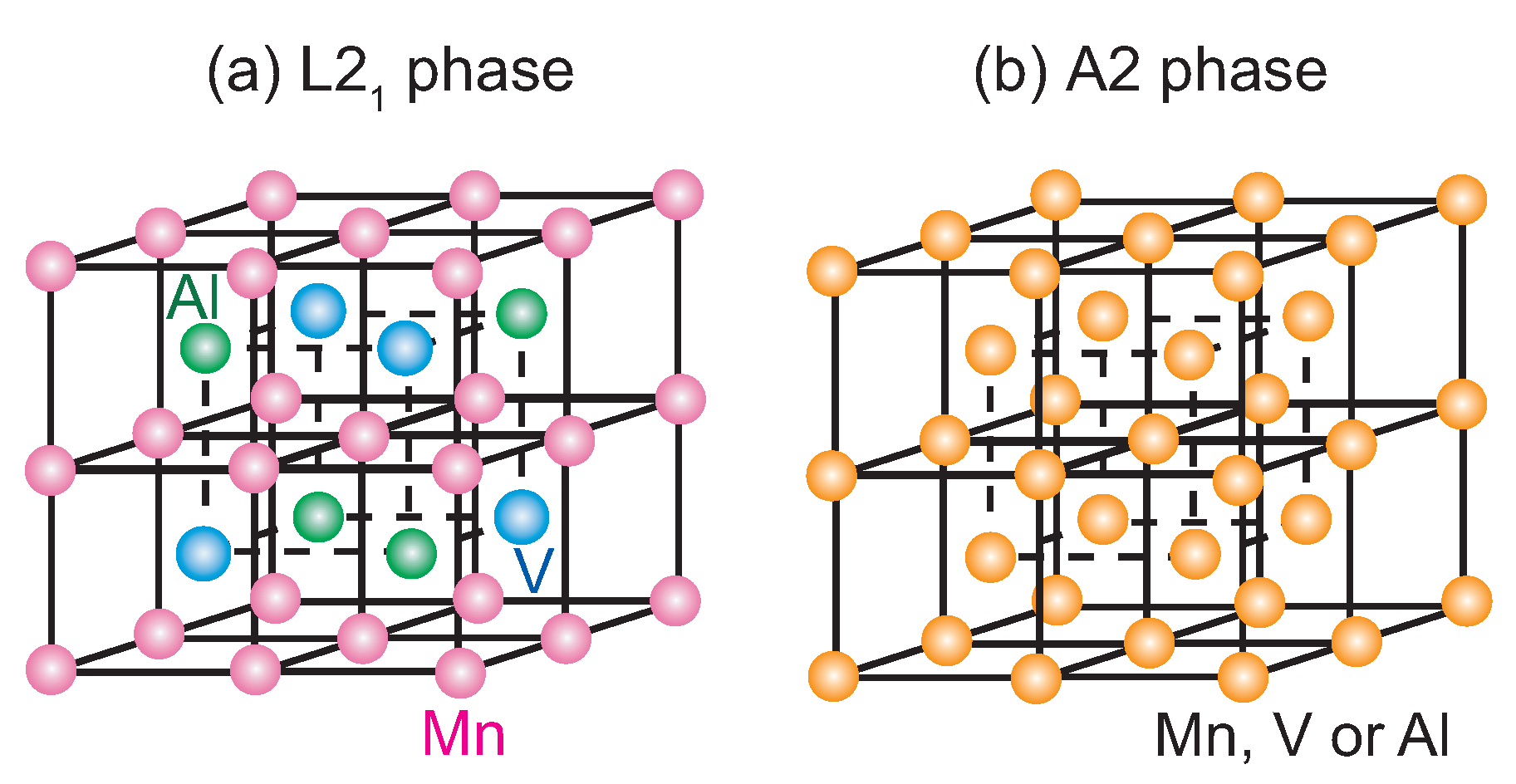
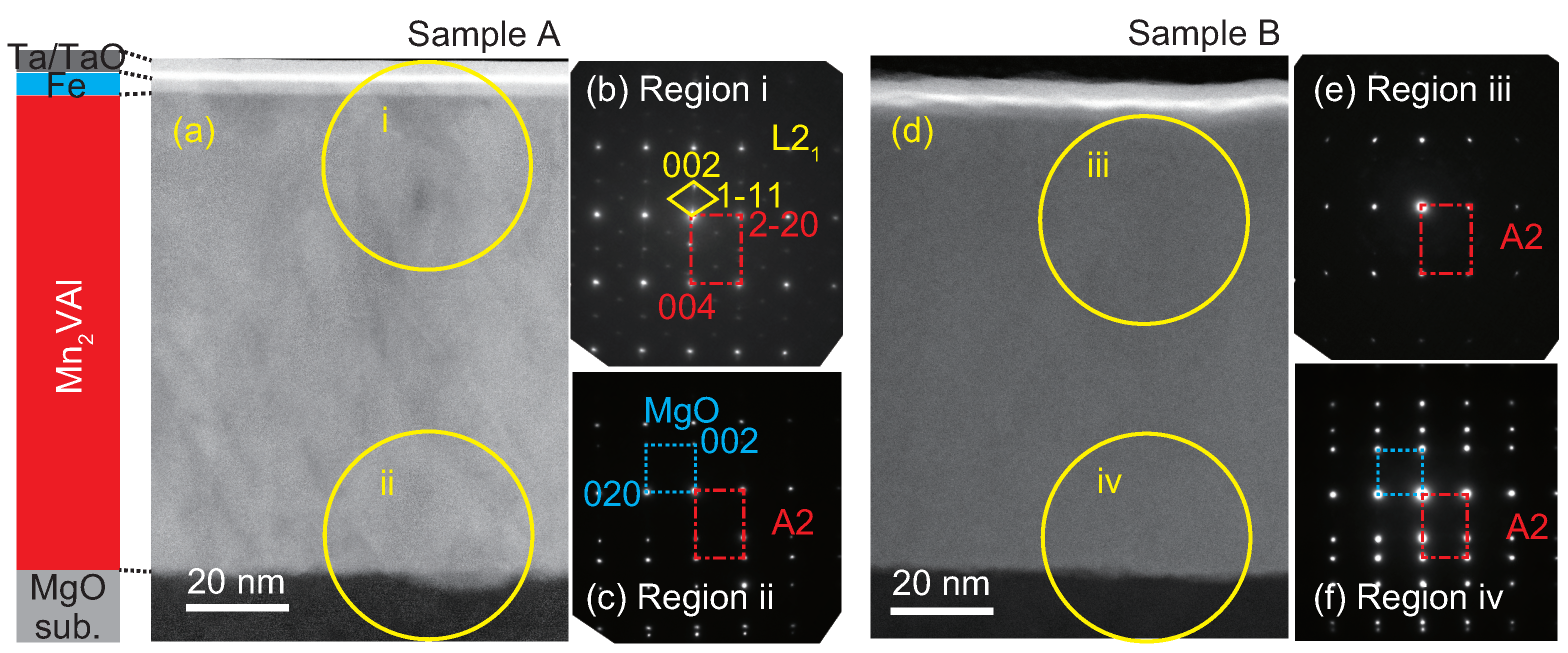


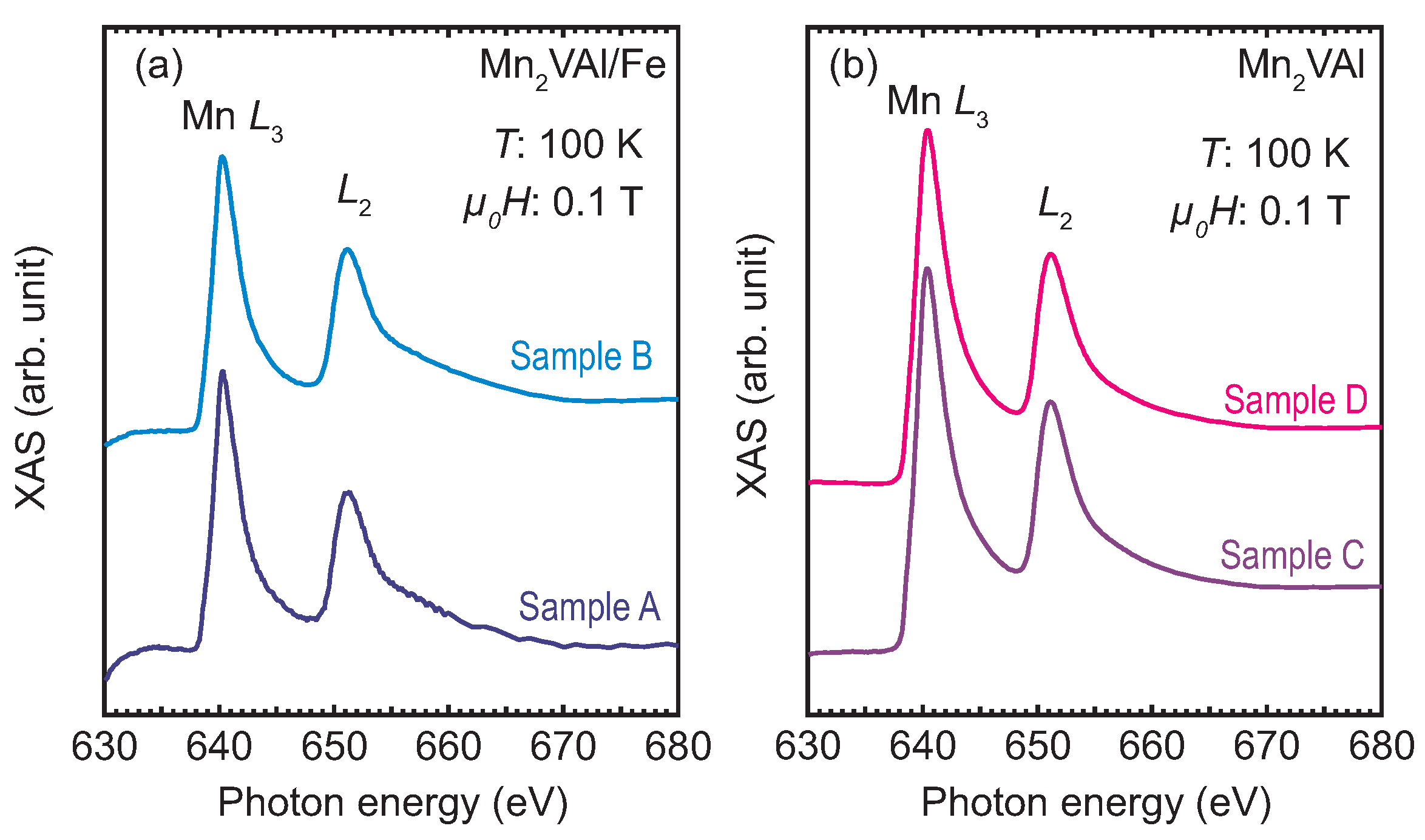

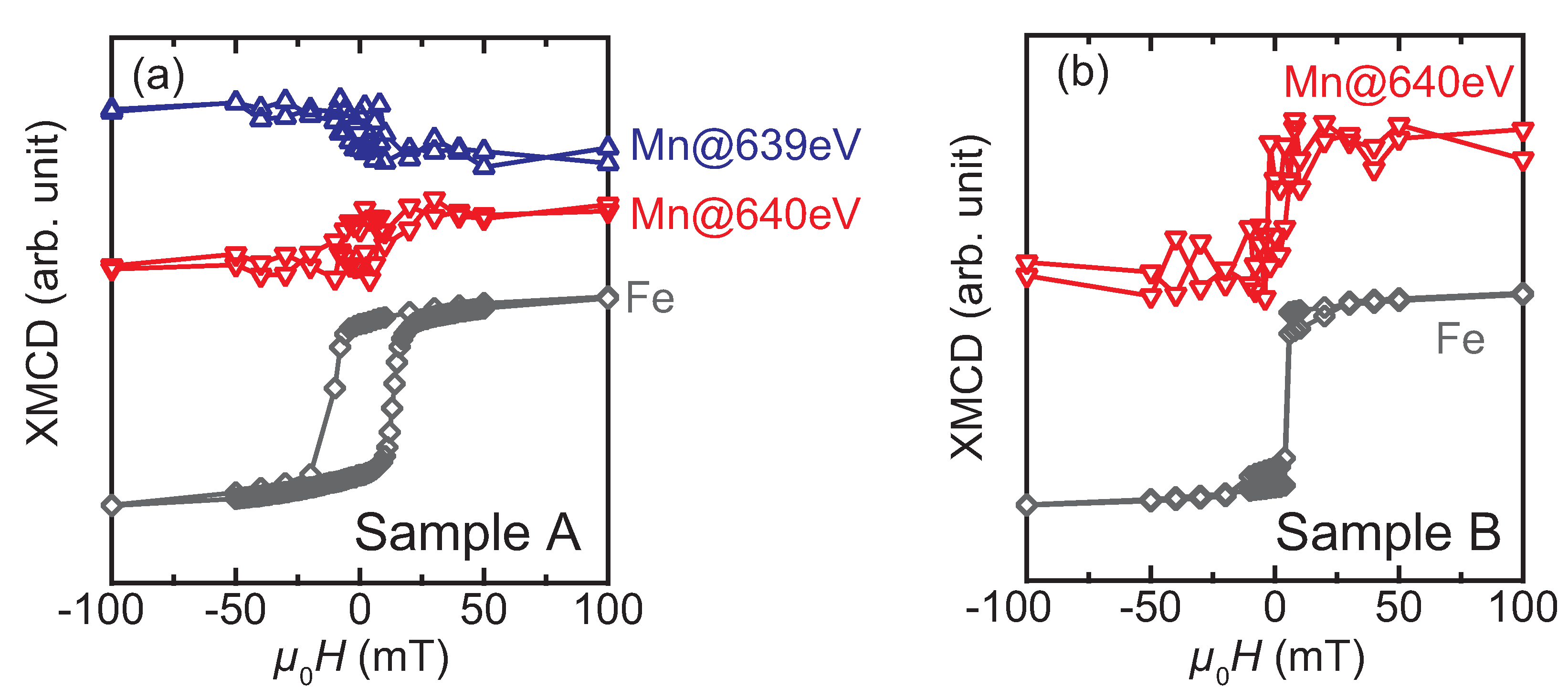
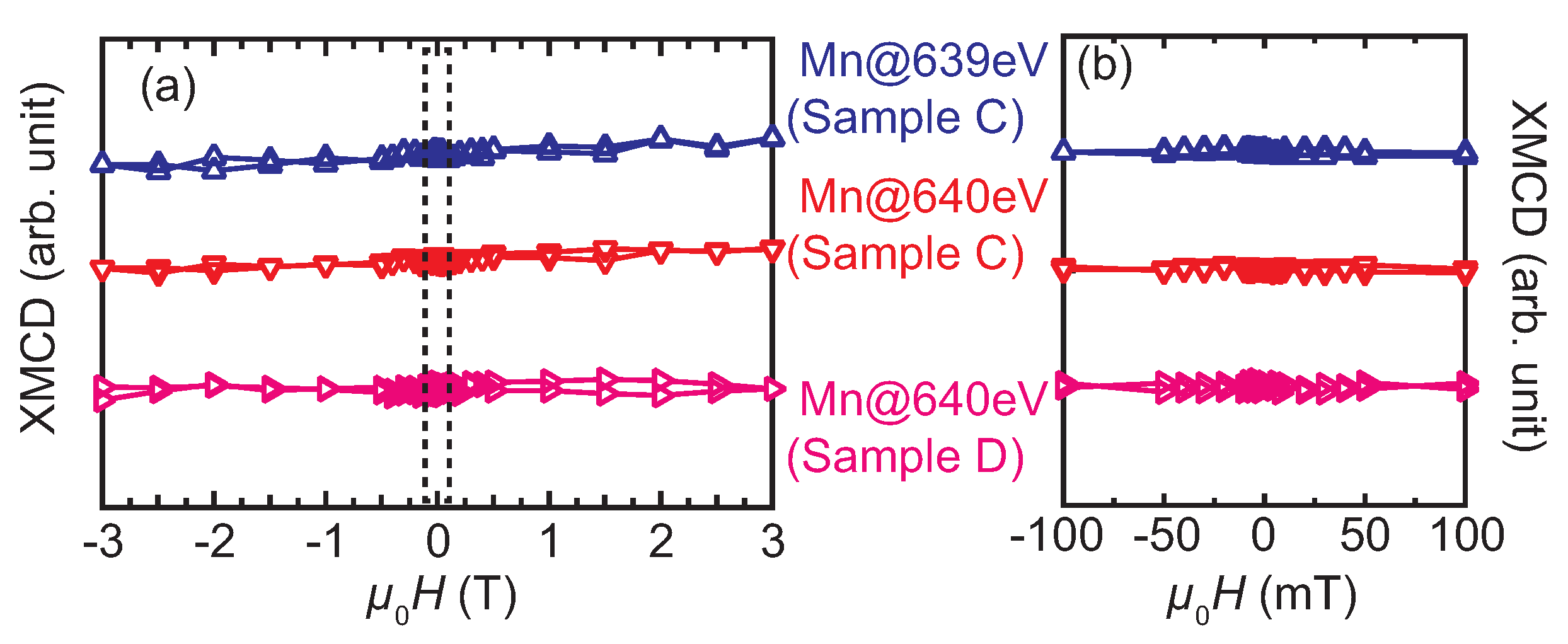

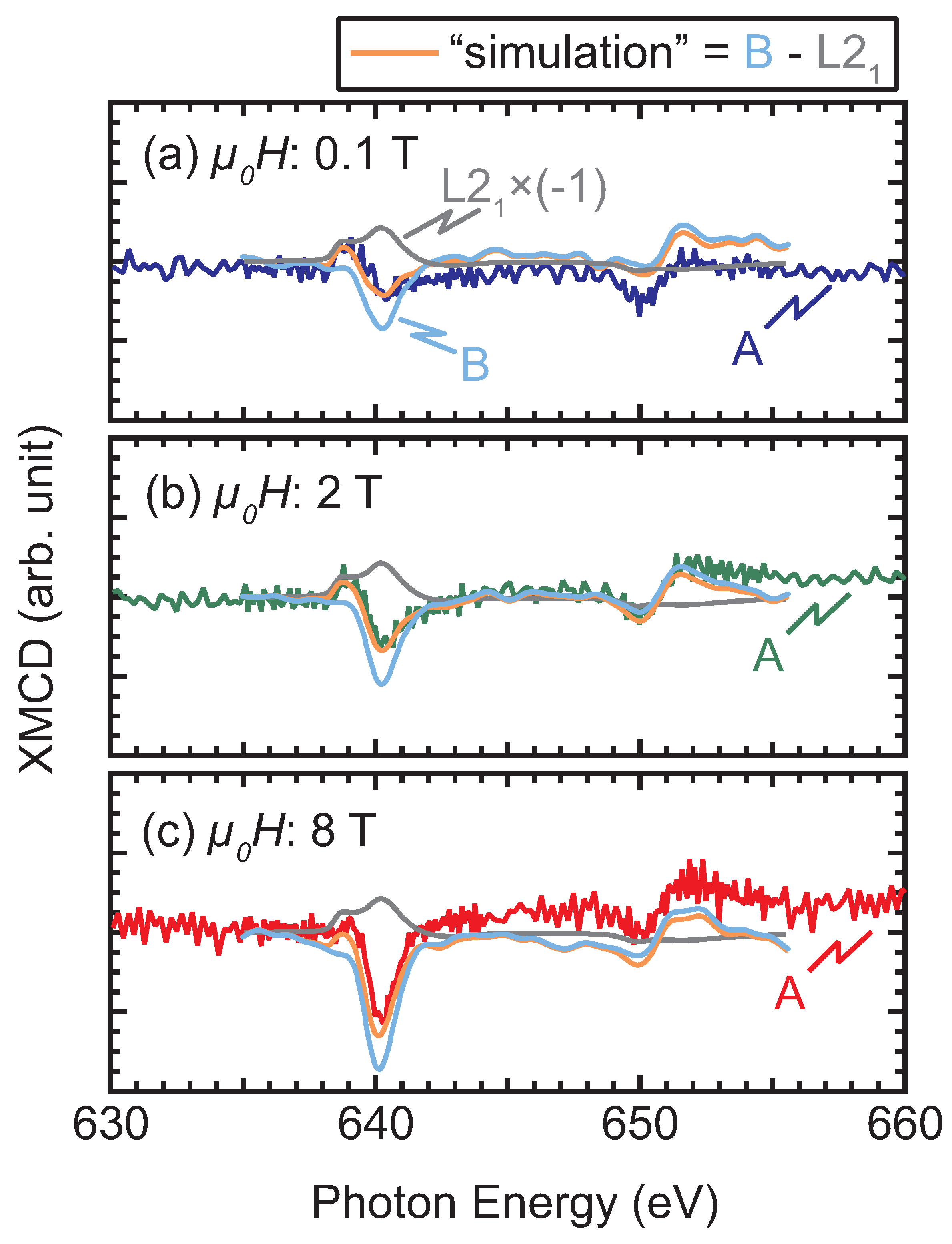
| Sample | for MnVAl | AF or para | Exchange Bias | |
|---|---|---|---|---|
| A | 400 °C | 3 nm | AF | Yes |
| B | room temp. | 3 nm | para | none |
| C | 400 °C | 0 | AF | - |
| D | room temp. | 0 | para | - |
Publisher’s Note: MDPI stays neutral with regard to jurisdictional claims in published maps and institutional affiliations. |
© 2021 by the authors. Licensee MDPI, Basel, Switzerland. This article is an open access article distributed under the terms and conditions of the Creative Commons Attribution (CC BY) license (https://creativecommons.org/licenses/by/4.0/).
Share and Cite
Kubota, T.; Shimada, Y.; Tsuchiya, T.; Yoshikawa, T.; Ito, K.; Takeda, Y.; Saitoh, Y.; Konno, T.J.; Kimura, A.; Takanashi, K. Microstructures and Interface Magnetic Moments in Mn2VAl/Fe Layered Films Showing Exchange Bias. Nanomaterials 2021, 11, 1723. https://doi.org/10.3390/nano11071723
Kubota T, Shimada Y, Tsuchiya T, Yoshikawa T, Ito K, Takeda Y, Saitoh Y, Konno TJ, Kimura A, Takanashi K. Microstructures and Interface Magnetic Moments in Mn2VAl/Fe Layered Films Showing Exchange Bias. Nanomaterials. 2021; 11(7):1723. https://doi.org/10.3390/nano11071723
Chicago/Turabian StyleKubota, Takahide, Yusuke Shimada, Tomoki Tsuchiya, Tomoki Yoshikawa, Keita Ito, Yukiharu Takeda, Yuji Saitoh, Toyohiko J. Konno, Akio Kimura, and Koki Takanashi. 2021. "Microstructures and Interface Magnetic Moments in Mn2VAl/Fe Layered Films Showing Exchange Bias" Nanomaterials 11, no. 7: 1723. https://doi.org/10.3390/nano11071723
APA StyleKubota, T., Shimada, Y., Tsuchiya, T., Yoshikawa, T., Ito, K., Takeda, Y., Saitoh, Y., Konno, T. J., Kimura, A., & Takanashi, K. (2021). Microstructures and Interface Magnetic Moments in Mn2VAl/Fe Layered Films Showing Exchange Bias. Nanomaterials, 11(7), 1723. https://doi.org/10.3390/nano11071723






